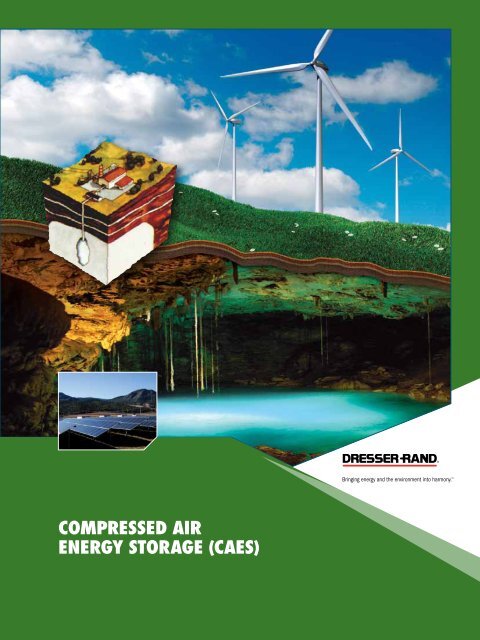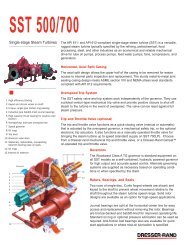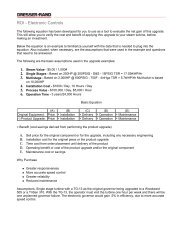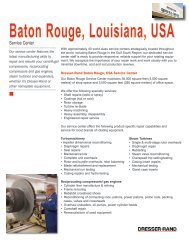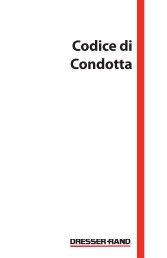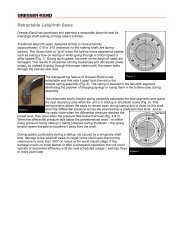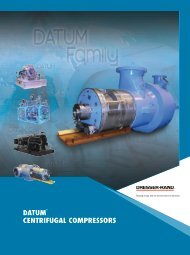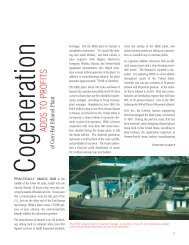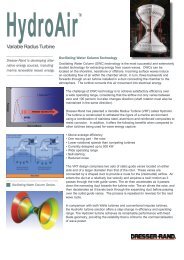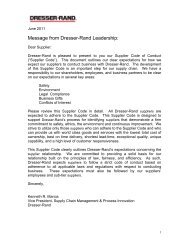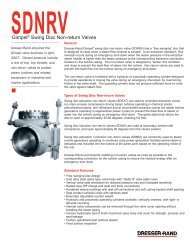Compressed Air Energy Storage ( CAES) - 85164 - Dresser-Rand
Compressed Air Energy Storage ( CAES) - 85164 - Dresser-Rand
Compressed Air Energy Storage ( CAES) - 85164 - Dresser-Rand
Create successful ePaper yourself
Turn your PDF publications into a flip-book with our unique Google optimized e-Paper software.
COMPRESSED AIR<br />
ENERGY STORAGE (<strong>CAES</strong>)<br />
Bringing energy and the environment into harmony. SM
unique load management<br />
and generation “on demand”<br />
Unmatched experience<br />
makes <strong>Dresser</strong>-<strong>Rand</strong> your<br />
partner of choice.<br />
Bringing energy and the environment into harmony. SM<br />
This <strong>CAES</strong> equipment built<br />
by <strong>Dresser</strong>-<strong>Rand</strong> has been<br />
performing reliably in McIntosh,<br />
Alabama since 1991.<br />
From <strong>CAES</strong> PionEEr<br />
to <strong>CAES</strong> LEAdEr<br />
<strong>Dresser</strong>-<strong>Rand</strong> is uniquely<br />
qualified to deliver total<br />
demand management and<br />
power generation using<br />
<strong>Compressed</strong> <strong>Air</strong> <strong>Energy</strong><br />
<strong>Storage</strong> (<strong>CAES</strong>) solutions. We<br />
designed and supplied the<br />
entire turbomachinery train<br />
and controls for the first <strong>CAES</strong><br />
plant in North America. Only<br />
the second of its type in the<br />
world, Power South’s McIntosh,<br />
Alabama, USA facility has<br />
been building an impressive<br />
record of starting reliably more<br />
than 90 percent of the time,<br />
and demonstrating greater<br />
than 95 percent reliable<br />
operation since 1991.<br />
FLExibLE SoLutionS<br />
From A SingLE SourCE<br />
<strong>Dresser</strong>-<strong>Rand</strong> can supply<br />
the entire <strong>CAES</strong> train. Our<br />
teamwork reduces your<br />
project management time,<br />
and single-source packaging<br />
minimizes transaction and<br />
transportation costs.<br />
We custom-engineer each<br />
<strong>CAES</strong> train to provide you with<br />
a system designed specifically<br />
to meet your site’s operating<br />
and geologic requirements. We<br />
select and fine-tune standard<br />
<strong>Dresser</strong>-<strong>Rand</strong> components for<br />
your project, then we make<br />
sure that all components will<br />
work together to maximize efficiency,<br />
and reduce installation<br />
and start-up times. Systems<br />
can be configured for salt caverns,<br />
hard-rock caverns, aquifers,<br />
or depleted natural gas<br />
fields on land or sea.<br />
FuturE oPPortunitiES<br />
For <strong>CAES</strong> SoLutionS<br />
Ever alert to workable solutions,<br />
<strong>Dresser</strong>-<strong>Rand</strong> engineers recently<br />
secured a patent for a sub-sea<br />
<strong>CAES</strong> concept that combines a<br />
conventional <strong>CAES</strong> facility with a<br />
sub-sea piping and compressed<br />
air storage system. Such a<br />
structure could bring <strong>CAES</strong><br />
technology to a wide range of<br />
coastal locations that represent<br />
nearly 80 percent of the world’s<br />
demand for electricity.<br />
Furthermore, the growing interest<br />
in wind and solar energy<br />
has spurred interest in <strong>CAES</strong><br />
technology. Wind farms typically<br />
generate more electricity<br />
at night when there already is a<br />
surplus of electricity. The ability<br />
to “bottle” this electric energy<br />
for daytime use (when it is most<br />
valuable) is an attractive consideration.<br />
Likewise, electricity from<br />
photo-voltaic farms in “sunny”<br />
regions could be sent through<br />
high-voltage DC transmission<br />
lines to <strong>CAES</strong> facilities elsewhere,<br />
where turbines would<br />
generate electricity year-round.<br />
<strong>CAES</strong> technology gives utility<br />
operators the means to operate<br />
their base load plants more<br />
efficiently and provides a solution<br />
for balancing the grid. And<br />
it enables green technologies<br />
such as solar cells and wind turbines<br />
to be matched with daily<br />
and weekly demand requirements<br />
for electricity.
unmatched<br />
experience.<br />
The only <strong>CAES</strong> plant operating in<br />
North America, the Power South<br />
facility continues to meet its peak<br />
load demands on a daily basis. To<br />
date, the train has started reliably<br />
more than 90 percent of the time,<br />
and demonstrated greater than 95<br />
percent reliable operation (running).<br />
As changing market forces make<br />
<strong>CAES</strong> increasingly attractive, this<br />
ongoing success makes the Power<br />
South plant’s major equipment<br />
supplier, <strong>Dresser</strong>-<strong>Rand</strong>, the logical<br />
choice for developing the next<br />
generation of <strong>CAES</strong> facilities.<br />
CAEs Plant Builds<br />
impressive Record<br />
Since 1991, a <strong>CAES</strong> plant in McIntosh,<br />
Alabama has been producing up to<br />
110 MW of electrical power during<br />
periods of high peak demand. The<br />
plant’s owner, Power South, uses it to<br />
boost its power capabilities during the<br />
peak daytime periods when demand for<br />
electric energy skyrockets. “Our load is<br />
primarily residential,” says plant manager<br />
Lee Davis. “<strong>CAES</strong> fits well with our load<br />
shape. Basically, I’m very much for the<br />
<strong>CAES</strong> concept.”<br />
The facility uses excess electricity<br />
generated by a Power South coal-fired<br />
plant during off-peak hours (when<br />
electricity costs are lowest) to compress<br />
air for storage. It then uses that air to<br />
generate electricity and sell it at a higher<br />
price during peak periods. “We buy low<br />
and sell high,” Davis says.<br />
“Normal startup for us is 14 minutes<br />
to reach 110 MW,” says Davis. “I can<br />
run down to 10 MW. It’s just a better<br />
regulating tool.” A dispatcher controls<br />
both the plant’s compression and power<br />
generation cycles via microwave from<br />
90 miles away.<br />
The 140-foot train, one of the longest<br />
in the world, is almost exclusively<br />
<strong>Dresser</strong>-<strong>Rand</strong> equipment. It is technically<br />
derived from <strong>Dresser</strong>-<strong>Rand</strong> product lines<br />
13-YEAR AVERAgE REliABiliTY<br />
COMPREssiOn gEnERATiOn<br />
Starting Running Starting Running<br />
92.7% 99.6% 91.6% 96.7%<br />
that have been time- and field-tested<br />
for decades in other applications.<br />
The equipment includes single-stage<br />
turbines, standard multi-stage turbines,<br />
packaged geared turbine generators<br />
and engineered turbine generators,<br />
centrifugal and axial compressors, gas<br />
turbines, and reciprocating compressors.<br />
The train has a centrally located motor/<br />
generator with clutches on both sides.<br />
On one side, a low-pressure compressor,<br />
intermediate compressor and highpressure<br />
compressor work to store<br />
air in a salt dome at pressures up to<br />
1100 psig. Four stages of compression<br />
and three inter-coolers are used to<br />
enhance cycle efficiency by minimizing<br />
compressor power.<br />
When electric power demand peaks<br />
during the day, the process is reversed.<br />
The compressed air is returned to the<br />
surface, heated, and run through highpressure<br />
and low-pressure expanders<br />
to power the motor/generator to<br />
generate electricity.<br />
Power South uses an underground salt<br />
dome for compressed air storage. “We<br />
solution mined it for 629 days,” Davis<br />
recalls. “That created 19 million cubic<br />
feet of cavern storage.”
CAEs<br />
A Smart Choice for Many Utilities<br />
increases efficiency and<br />
extends base load unit life—<br />
<strong>CAES</strong> facilities enable you to<br />
optimize your base load units<br />
by minimizing load swings<br />
to maximize efficiency and<br />
extend unit life. Storing energy<br />
lets you use off-peak power<br />
to meet peak demand. This<br />
is less expensive than using<br />
traditional gas turbine peaking<br />
units or purchasing power from<br />
other sources.<br />
1.<br />
UNDERGROUND<br />
AIR STORAGE CAVERN<br />
Schematic of traditional <strong>CAES</strong> process showing<br />
air flow into and out of the storage cavern.<br />
2.<br />
Responds quickly—A <strong>CAES</strong><br />
generator is designed to be<br />
started and brought to full<br />
load in as little as 10 minutes,<br />
eliminating the need for intermediate-load<br />
plants and providing<br />
a cost-effective way to meet<br />
spinning reserve requirements.<br />
<strong>CAES</strong> generators also have<br />
excellent load-following capability<br />
and very good part-load<br />
efficiency. Compressors can be<br />
engaged quickly to absorb load<br />
rather than reducing your base<br />
load generation.<br />
3.<br />
4.<br />
Flexible cycling options—<br />
The <strong>CAES</strong> system is available<br />
for compression duty when<br />
it’s not in power generation<br />
mode, and can be configured<br />
for daily, weekly, or extended<br />
cycles. This allows you to<br />
“grid balance,” and use<br />
inexpensive power for air<br />
storage (charging).<br />
Environmentally friendly—<br />
<strong>CAES</strong> has environmental<br />
advantages compared to<br />
conventional gas turbines<br />
because its combustors use<br />
as little as two-thirds the fuel.<br />
Furthermore, <strong>CAES</strong> can be an<br />
attractive alternative to the<br />
costly modifications required<br />
to make coal-burning plants<br />
comply with increasingly<br />
stringent fossil fuel<br />
emissions requirements.<br />
A <strong>CAES</strong> PrimEr<br />
In a <strong>CAES</strong> plant, available<br />
off-peak electricity is used to<br />
power a motor/generator that<br />
drives compressors to force air<br />
into an underground storage<br />
reservoir at high pressures.<br />
This process (called “charging”)<br />
usually occurs at night,<br />
and during weekends when<br />
utility system demands and<br />
electricity costs are low.<br />
5.<br />
During intermediate electrical<br />
demand periods, the air is<br />
released from the reservoir,<br />
and without further compression<br />
is heated and expanded<br />
through gas- or fuel oil-fired<br />
combustion turbines to drive<br />
the same motor/generator to<br />
produce electrical power.<br />
<strong>Compressed</strong> air may be stored<br />
in certain reservoirs created<br />
by solution mining bedded or<br />
domed salt formations; conventionally<br />
mining solid rock; or in<br />
aquifers and depleted natural<br />
gas fields. These formations<br />
can be found around the world.<br />
Long-tErm SErViCE<br />
AgrEEmEntS (LtSA)<br />
<strong>Dresser</strong>-<strong>Rand</strong> offers long-term<br />
service agreements (LTSA) to<br />
clients who require personnel<br />
to supplement or replace<br />
their maintenance organizations.<br />
A typical LTSA includes<br />
project management, technical<br />
services, field crews, and support<br />
from our OEM technical<br />
resource network. Our field<br />
teams are OEM-trained, fully<br />
equipped, committed to safety,<br />
and logistically prepared to<br />
provide professional and timely<br />
services to keep your critical<br />
equipment on-line, or restore it<br />
to full operation.<br />
6.
moduLAr dESign ALLowS EACh SyStEm<br />
to bE ConFigurEd For mAximum EFFiCiEnCy<br />
90'<br />
Increased flexibility for simultaneous compression<br />
and power generation and quicker transition time<br />
between power generation and compression.<br />
144'<br />
Matching power generation with compression<br />
flow requirements for air storage in salt domes<br />
or hard rock caverns.<br />
116'<br />
Matching power generation with lower discharge<br />
pressure requirements for air storage in aquifers.<br />
7.<br />
140'<br />
8.<br />
110 MW conventional<br />
<strong>CAES</strong> turbomachinery train.<br />
9.<br />
FLExibLE oPErAtion to<br />
mEEt CuStom rEQuirEmEntS<br />
Modular, single-shaft train uses proven<br />
equipment designed to meet stringent<br />
American Petroleum Institute (API) standards<br />
Flexible operation modes available<br />
Low operation and maintenance life<br />
cycle costs achieved by:<br />
- Smaller, less expensive turbine<br />
components<br />
- Standard modules and replacement parts<br />
- Longer time between overhauls<br />
(compared to conventional<br />
high-temp gas turbines)<br />
- Lower fuel consumption (less than<br />
two-thirds that of equivalent gas turbines)<br />
- Wide turn-down (load) with only moderate<br />
reductions in efficiency<br />
- Higher efficiency at partial load<br />
Only a portion of the plant capacity is lost<br />
if a module of the <strong>CAES</strong> system is down<br />
for maintenance (compared to plants with<br />
large steam turbine units)<br />
Incremental capacity—development<br />
of storage sites<br />
Short lead times<br />
Rapid start—in as little as<br />
10 minutes to full load<br />
Motor/generator can be used as a<br />
synchronous condenser to improve the<br />
system’s power factor<br />
Output not affected by ambient temperatures<br />
LEgEnd<br />
1. High-pressure compressor 8. Clutch<br />
2. Intermediate-pressure 9. Low-pressure expander<br />
compressor<br />
10. Low-pressure combustors<br />
3. Speed-increasing gear<br />
11. High-pressure expander<br />
4. Turning gear<br />
12. High-pressure combustors<br />
5. Low-pressure compressor<br />
13. Turning gear<br />
6. Clutch<br />
14. <strong>Air</strong> throttle valve<br />
7. Motor/generator<br />
15. <strong>Air</strong> trip valve<br />
11.<br />
12.<br />
13.<br />
14.<br />
15.
sMART <strong>CAES</strong> <br />
Enhanced Renewable<br />
<strong>Energy</strong> Solutions<br />
Dubbed SMART<strong>CAES</strong> equipment<br />
and services, this enhanced offering<br />
is more than a name; it’s a reflection<br />
of <strong>Dresser</strong>-<strong>Rand</strong>’s unique qualification<br />
to deliver the total integrated rotating<br />
equipment system—a “one-stop” <strong>CAES</strong><br />
solution. This solution includes not only<br />
the rotating equipment, but all ancillary<br />
services as well—the heat exchange<br />
equipment, pollution abatement system,<br />
and the plant controls—complete with<br />
performance guarantees (both compression<br />
and power generation modes).<br />
Over the years, related research and<br />
development from other <strong>Dresser</strong>-<strong>Rand</strong><br />
products have been incorporated into<br />
our <strong>CAES</strong> offering (e.g., DATUM ® compressor<br />
technology enhancements), and<br />
these ever-improving technologies have<br />
put <strong>CAES</strong> at the “head of its class” on<br />
every relevant subject.<br />
SmArt on tEChnoLogy<br />
Technological advancements achieved<br />
since first introducing the <strong>CAES</strong> design<br />
for the McIntosh facility bring a range of<br />
benefits to <strong>Dresser</strong>-<strong>Rand</strong>’s SMART<strong>CAES</strong><br />
equipment, including operating flexibility,<br />
increased power output, reduced fuel<br />
and air consumption, improved compressor<br />
efficiency, noise reduction, and<br />
improved recuperator design.<br />
Operating flexibility—SMART<strong>CAES</strong><br />
equipment offers shorter startup times<br />
to achieve rated output in power generation<br />
mode, higher load ramping rates in<br />
power generation mode, faster compression<br />
start-up times, and faster transition<br />
between compression and power<br />
generation modes.<br />
Speed - RPM<br />
Speed - RPM<br />
Power Generation Mode - Normal Start-up Sequence<br />
10 Minutes To 100% Output<br />
4000<br />
150<br />
3600<br />
140<br />
130<br />
3200<br />
2800<br />
Speed<br />
Gen.<br />
Sync<br />
Power<br />
120<br />
110<br />
100<br />
2400<br />
26 MW / min.<br />
Ramp Rate<br />
90<br />
2000<br />
Train Accelerated<br />
at 30rpm / sec<br />
80<br />
70<br />
1600<br />
60<br />
1200<br />
Initial Loading &<br />
LP Combustor Light<br />
50<br />
40<br />
800<br />
PREP<br />
400<br />
Initiation of <strong>Air</strong> Flow<br />
HP Combustor Light-up<br />
Initial Acceleration<br />
30<br />
20<br />
10<br />
0<br />
0 1 2 3 4 5 6 7 8 9 10 11<br />
0<br />
12<br />
Time - Minutes<br />
4000<br />
3500<br />
3000<br />
2500<br />
2000<br />
1500<br />
1000<br />
500<br />
FiguRE 1: Power generation mode—normal start-up sequence<br />
In power generation mode, the system is<br />
designed to start-up in less than 10 minutes<br />
to ramp output up to the rated 135<br />
MW. Once synchronized, any output from<br />
15 to 100 percent of rated load can be<br />
sustained indefinitely. Within this range,<br />
output may be ramped up or down at 20<br />
percent of rated load per minute, or 27<br />
MW per minute.<br />
<strong>CAES</strong> Compression Start Sequence Single Train - 400 lbm/sec Mass Flow<br />
PREP<br />
0<br />
0.00 0.50 1.00 1.50 2.00 2.50 3.00 3.50<br />
Time - Minutes<br />
A variable speed drive system provides for<br />
rapid compression starts requiring less<br />
than 3.5 minutes. Once air is flowing to<br />
storage, the compressors may be turned<br />
down to any load between 65 and 100<br />
percent of rated power, using variable inlet<br />
guide vanes, at a rate of 35 percent per<br />
minute (see figures 1 and 2).<br />
For single train systems using a combination<br />
motor-generator, the variable frequency<br />
drive (VFD) system can be used to<br />
speed up the transitions between power<br />
generation and compression modes.<br />
Transitioning from power generation to<br />
compression can be achieved in five<br />
Compression Mode Normal Start Sequence<br />
Start to Full Load in Less Than 4 Minutes<br />
Accelerate To Speed w/VFD<br />
Synchronize<br />
- Close Blow-off Valves<br />
- Open Throttle Valves<br />
FiguRE 2: Compression mode normal start sequence<br />
Power - MW<br />
120<br />
100<br />
0<br />
4.00<br />
minutes, while adjusting from compression<br />
to power generation requires about<br />
13 minutes. Multiple train systems, with<br />
separate motors for compression and<br />
generators for power production, eliminate<br />
mode transition time. The maximum<br />
transition time equals startup time in the<br />
desired mode.<br />
Power output—The output of SMART<strong>CAES</strong><br />
turbo expanders was increased from 110<br />
MW to 135 MW. Combining modern analytical<br />
techniques and upgraded materials,<br />
the calculated safety factors for both the<br />
high-pressure and low-pressure turbines’<br />
flowpaths remain virtually unchanged,<br />
despite a total output increase exceeding<br />
20 percent.<br />
Fuel and air consumption—Turbine and<br />
system enhancements such as better recuperator<br />
effectiveness result in a two percent<br />
heat rate improvement, coupled with a 1.2<br />
percent reduction in specific air consumption<br />
(SAC), across the design operating<br />
range from 20 MW to 135 MW. The heat<br />
80<br />
60<br />
40<br />
20<br />
Compressor Load - MW
Heat Rate (Btu/KW-Hr)<br />
15000<br />
13000<br />
11000<br />
9000<br />
7000<br />
5000<br />
rate of the <strong>Dresser</strong>-<strong>Rand</strong> SMART<strong>CAES</strong><br />
expanders is low and flat over a wide range<br />
of turndown from 100 percent load to 25<br />
percent load because the expanders operate<br />
independent of the air compressors<br />
(see figure 3).<br />
Compressor efficiency—<strong>Dresser</strong>-<strong>Rand</strong>’s<br />
DATUM centrifugal compressor technology,<br />
more advanced axial compressor flowpath<br />
aerodynamics and careful design of the<br />
intercooled compression cycle all provide<br />
significant improvements in overall efficiency.<br />
Depending on final parameters, overall<br />
compression train flange-to-flange polytropic<br />
efficiency is in the mid-80 percent range in<br />
terms of energy consumption. The efficiency<br />
of the Power South <strong>CAES</strong> compressor train<br />
installed and operating in McIntosh is in the<br />
low 80 percent range (approximately three<br />
percent lower than <strong>Dresser</strong>-<strong>Rand</strong>’s current<br />
<strong>CAES</strong> offering).<br />
noise reduction—Our patented noise<br />
reduction technology (D-R ® duct resonator<br />
array) can achieve up to a 10 dB reduction<br />
in noise levels compared to centrifugal<br />
compressors that do not utilize this<br />
acoustic technology.<br />
Recuperator design—The exhaust<br />
recuperator is a simpler design, with 85<br />
percent heat transfer effectiveness compared<br />
to 75 percent in the earlier design.<br />
Strategically placed rows of stainless<br />
steel tubes avoid corrosion and exfoliation<br />
problems, and the entire recuperator<br />
is designed to operate at maximum air<br />
storage pressure, eliminating the cost and<br />
maintenance of pressure reducing valves.<br />
This change also makes sliding pressure<br />
cycles feasible where advantageous.<br />
Heat Rate Comparison<br />
<strong>Dresser</strong>-<strong>Rand</strong> <strong>CAES</strong> vs Simple Cycle Gas Turbine<br />
Typical Gas Turbine Simple Cycle<br />
<strong>Dresser</strong>-<strong>Rand</strong> <strong>CAES</strong> Expanders<br />
3000<br />
0 20 40 60 80 100<br />
% Load (Rated Load = 135MW)<br />
FiguRE 3: Heat rate comparison<br />
120<br />
SmArt on thE EnVironmEnt<br />
The technological improvements to<br />
SMART<strong>CAES</strong> equipment and services offer<br />
emission control options capable of meeting<br />
all current regulatory requirements for<br />
NO X and CO limits. With features that can<br />
meet current emissions requirements,<br />
SMART<strong>CAES</strong> equipment can do its part<br />
to reduce the buildup of greenhouse<br />
gases in the atmosphere and combat<br />
climate change.<br />
A simple diffusion flame combustor with<br />
H 2 O injection for primary NO X control,<br />
coupled with an exhaust selective catalytic<br />
reduction system for final NO X control,<br />
provides stable operation at high turndown<br />
ratios. It’s possible to achieve final<br />
exhaust emission levels of 2 ppm NO X and<br />
2 ppm CO, corrected to 15 percent O 2 .<br />
This means, depending on the operating<br />
profile, many potential <strong>CAES</strong> sites would<br />
fall under small-source emission limit<br />
rules. In addition, the VFD system<br />
reduces the compression start time,<br />
eliminating expander emissions from<br />
compression starts.<br />
When used in conjunction with renewable<br />
energy such as wind or solar, SMART<strong>CAES</strong><br />
equipment has one-third the emissions of<br />
a conventional gas turbine.<br />
SmArt on buSinESS<br />
The world’s increasing focus on cleaner,<br />
greener energy use presents <strong>Dresser</strong>-<strong>Rand</strong><br />
with an ideal opportunity to successfully<br />
integrate our <strong>CAES</strong> technology into<br />
new markets.<br />
We recently secured a patent for a concept<br />
to combine a conventional <strong>CAES</strong><br />
facility with a sub-sea piping and compressed<br />
air storage system. Such a<br />
structure could bring <strong>CAES</strong> technology<br />
to a range of coastal locations that<br />
represent nearly 80 percent of the<br />
world’s demand for electricity.<br />
The growing popularity of wind and<br />
solar energy could also spur interest<br />
in SMART<strong>CAES</strong> solutions. Wind farms<br />
typically generate more electricity at<br />
night, when there’s already a surplus,<br />
and the ability to “bottle” electric<br />
energy for daytime use is an attractive<br />
option. Within the solar market, electricity<br />
from photo-voltaic farms in sunny<br />
regions could be transmitted to facilities<br />
that use SMART<strong>CAES</strong> equipment<br />
in other areas, where turbines would<br />
generate electricity year-round.<br />
The world would benefit from increased<br />
use of renewable energy sources, such<br />
as wind and solar, however, a common<br />
reality is that they are inherently intermittent<br />
and to some degree unreliable.<br />
SMART<strong>CAES</strong> equipment provides an<br />
excellent tool for “smart grid” management<br />
by having excellent load following<br />
capability, helping base load assets<br />
to be more efficiently utilized during<br />
off-peak times, and by being able to<br />
provide ancillary services such as VAR<br />
support, regulation and reserve.<br />
The dynamics of the worldwide energy<br />
market are changing, and SMART<strong>CAES</strong><br />
solutions are one example of how<br />
<strong>Dresser</strong>-<strong>Rand</strong> is repositioning its<br />
offerings to address global needs.<br />
Renewable energy sources can benefit<br />
from the bulk energy storage capabilities<br />
that SMART<strong>CAES</strong> equipment<br />
offers. SMART<strong>CAES</strong> equipment is also<br />
complementary to energy conservation<br />
and development efforts associated<br />
with the “smart grid,” giving utility<br />
operators the means to run their base<br />
load plants more efficiently.<br />
Considering the careful research,<br />
advancements and efficiencies surrounding<br />
SMART<strong>CAES</strong> equipment and<br />
services, its potential benefits are an<br />
obvious choice for creating an efficient<br />
power generation system.
Form 85230<br />
FPO<br />
For a complete list of products and services, visit www.dresser-rand.com or contact the following:<br />
CORPORATE HEAdquARTERs<br />
<strong>Dresser</strong>-<strong>Rand</strong><br />
West8 Tower, Suite 1000<br />
10205 Westheimer Road<br />
Houston, Texas 77042<br />
Tel: (Int'l +1) 713-354-6100<br />
Fax: (Int'l +1) 713-354-6110<br />
<strong>Dresser</strong>-<strong>Rand</strong><br />
112, Avenue Kleber<br />
Cedex 16<br />
Paris 75784 France<br />
Tel: (Int’l +33) 156 26 71 71<br />
Fax: (Int’l +33) 156 26 71 72<br />
Email: info@dresser-rand.com<br />
REgiOnAl HEAdquARTERs<br />
The Americas<br />
West8 Tower, Suite 1000<br />
10205 Westheimer Road<br />
Houston, Texas 77042<br />
Tel: (Int’l +1) 713-354-6100<br />
Fax: (Int’l +1) 713-354-6110<br />
EMEA<br />
(Europe, Middle East & Africa)<br />
<strong>Dresser</strong>-<strong>Rand</strong> S.A.<br />
31 Boulevard Winston Churchill<br />
Cedex 7013<br />
Le Havre 76080, France<br />
Tel: (Int'l +33) 2-35-25-5225<br />
Fax: (Int'l +33) 2-35-25-5366/5367<br />
©2010 <strong>Dresser</strong>-<strong>Rand</strong>. DRESSER-RAND is a registered trademark of <strong>Dresser</strong>-<strong>Rand</strong> Group Inc. Printed in U.S.A.<br />
Asia-Pacific<br />
<strong>Dresser</strong>-<strong>Rand</strong> Asia Pacific Sdn Bhd<br />
Unit 9-4, 9th Floor<br />
Bangunan Malaysian Re<br />
17 Lorong Dungun<br />
Damansara Heights<br />
50490 Kuala Lumpur, Malaysia<br />
Tel: (Int'l +60) 3-2093-6633<br />
Fax: (Int'l +60) 3-2093-2622<br />
This brochure comprises a general overview of the <strong>Dresser</strong>-<strong>Rand</strong> products described herein. It is solely for informational purposes, does not represent<br />
a warranty or guarantee of the information contained herein, and is not to be construed as an offer to sell or solicitation to buy. Contact<br />
<strong>Dresser</strong>-<strong>Rand</strong> for detailed design and engineering information suitable to your specific applications. <strong>Dresser</strong>-<strong>Rand</strong> reserves the right to modify its<br />
products and related product information at any time without prior notice.<br />
Bringing energy and the environment into harmony. SM


